
Besides the obvious cleverness, this cartoon supposes that sometimes a solution is easier than assumed, or, right in front of your face.
You can test its formula by trying it out on more difficult material.

Besides the obvious cleverness, this cartoon supposes that sometimes a solution is easier than assumed, or, right in front of your face.
You can test its formula by trying it out on more difficult material.
Filed under adult learning
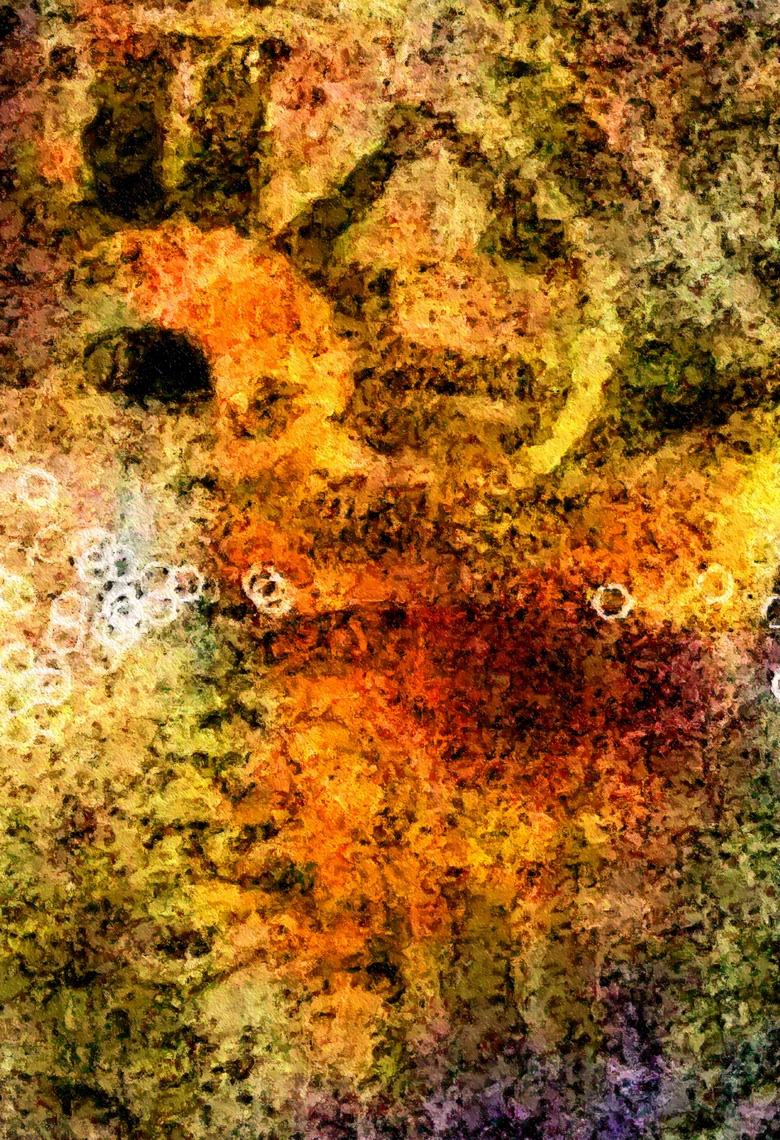
July 2013 – Buried – S.Calhoun
…pulled one across the line in July, a month that baked the studio for weeks and disrupted my sonic and visual creative experiments. Today continues a streak of unseasonably cool weather, conditions good for the garden, kitties, and creative production.
ongoing gallery at My Naive Art
Filed under visual experiments, my art
Theatre of Sport: Bali from SURFING Magazine on Vimeo.
Hey, while surfing Vimeo…
In prior posts. (here and here,) I tell of my very brief surfing moments during the summers of 1968 and 1969.
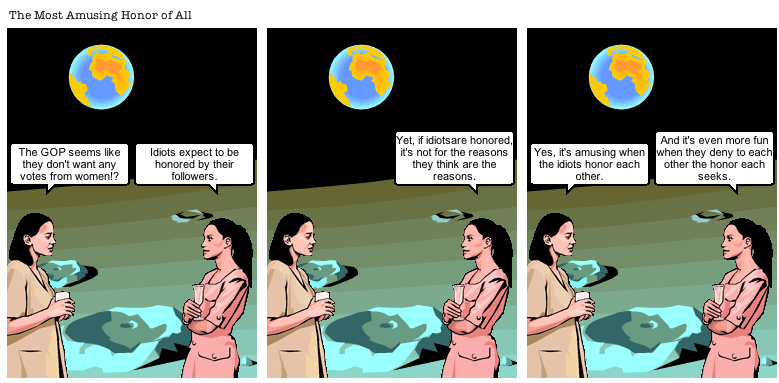
Idries Shah is the source for the dialog (and exposition) in this comic, but it was necessary to shift the subject matter a bit to repurpose its ‘learning function’ and attach it to a contemporary situation.
The reader likely will need to work a bit to tease out the subtle didactic aim of the exposition. The situation of the GOP stands in for all similar situations for which the actual mechanics of leading and following are willfully obscured and substituted with, and here’s the first hint, an idealization about different mechanics.
The subject matter is: the psychological problem of following leaders. What follows are some clues and only clues.
(1) David Corn writes about Project Groundswell, a group of conservative thought leaders working together to lead thoughts and improve followers’ reasons for following.
(2) The Impostor Syndrome: is when the pressure of knowing directly about one’s own faults undermines the effort to present one’s relatively faultless self to others. “If those suckers who worship me only knew what I know!”
(3) The extension of the story, The Emperor With No Clothes; so: what happens next to the followers?
Filed under adult learning, experiential learning, humor
III. The Future of Heights; Conference of Neighborhoods (part three of three parts)
The Lakewood Observer model has been going strong in Lakewood for almost a decade and has proliferated to encompass numerous Observer projects. The Cleveland Heights iteration is seemingly very healthy. <em>The Cleveland Heights Observer</em> is excellent. I’m delighted the civic journalism and civic self-knowledge project has taken root here.
The following video rambles but does so in intriguing ways.
2013 annual meeting, with speaker Peter Pula of Axiom News from future heights on Vimeo.
Susan and I go out to dinner every Saturday night. Even when we lived in Shaker Heights we were drawn seventy-five percent of the time to the many warm and tasty restaurants of Cleveland Heights, eateries lined up conveniently in the districts of Lee and Coventry and Cedar-at-Fairmount roads. I remarked to my wife that Cleveland Heights seemed to me to have realized the baby boomer boho heaven. By this I mean how it has happened that the equation of liberalism and livability and professional careerism has been answered by the large cohort of fifty and sixty-something empty nesters who have staked their hearts and claim to many neighborhoods in Cleveland Heights.
Of course, I know this characterization is not even half true. I understand at least from my years of summer garage sale questing, traveling through the variety of Cleveland Heights neighborhoods, that my home town is a percolating, teeming, diverse concoction.
I haven’t decided to begin to really train my attention on a compelling civic project, but I am paying attention. The neighborhoods of Cleveland Heights radiate distinctive, positive vibes. Generally, my home town’s people express lots of devotion and commitment. This shines through, and does so even as Cleveland Heights continues to grapple with all sorts of challenges.
I have an inchoate fantasy about what might happen if there was some forum or mechanism for Cleveland Heights neighborhoods to dialog and confer with each other.
But if we understand the nature of the personality, and the way that it is operative in history–steadily in small increments, intermittently in potent quantities–we shall be ready to take advantage of a singular point when it occurs. There is even a special touch of encouragement in Maxwell’s dictum that the higher the rank of existence the more frequent the occurrence of singular points. (Lewis Mumford, p232, The Conduct of Life)
Nowadays I sense the potential for singular points emerges from long chains of fortuity, something like civic affection, and, daring to know now, and know now for the sake of tomorrow.
Filed under adult learning, Cleveland, Kenneth Warren
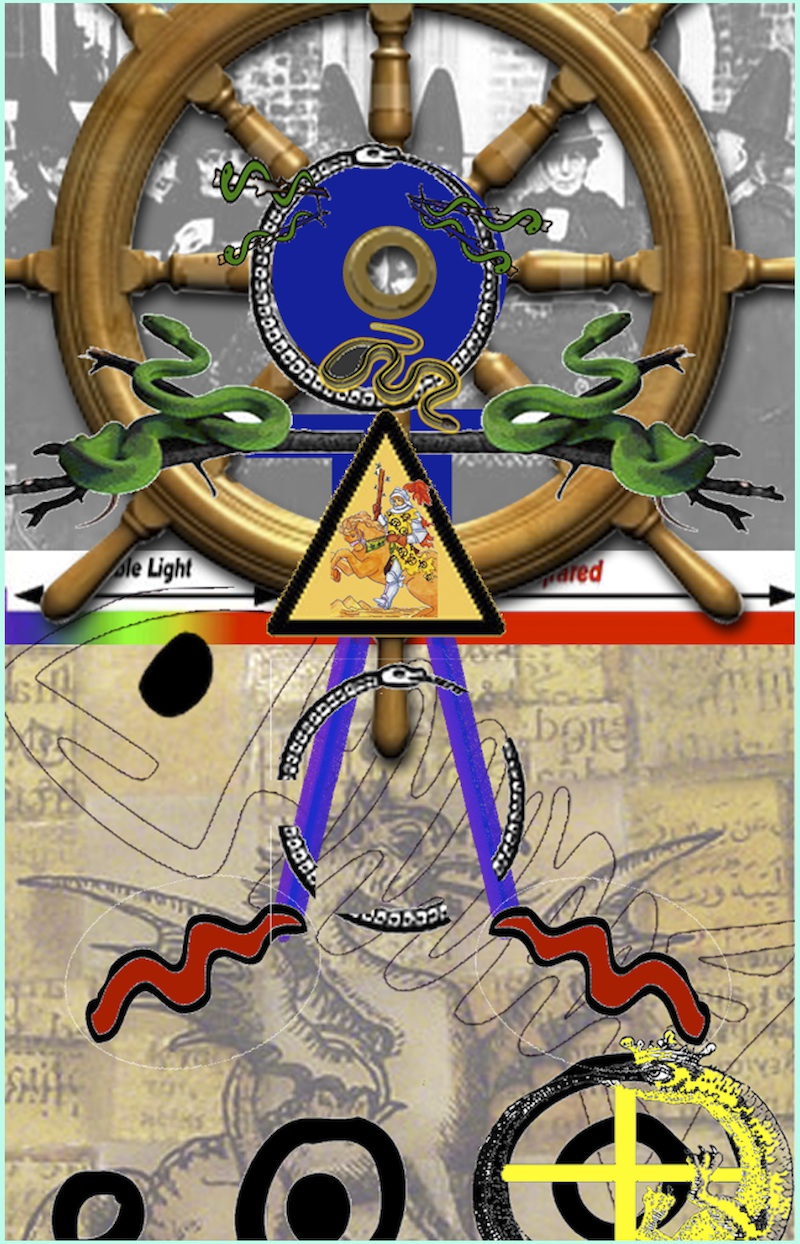
Totem For Lakewood; 2010 S.Calhoun
II. Roots of (My) Urbanology (part two of three parts)
In 1972, my mother suggested that I might find Lewis Mumford interesting. Although I was mostly concerned with–in 1972–squeezing through various doors of perception, I managed to wander through Mumford’s The Conduct of Life, along with Huxley and Laing and Watts. The Conduct of Life was written in 1951. (I suppose hardly anybody reads Mumford anymore.) A few years after returning to Cleveland in 1992, I remember revisiting Mumford in a series of conversations with my mother about Cleveland, cities, the de-industrialization of the Mid West, and, the curse of Ronald Reagan. She insisted I read The Death and Life of Great American Cities by Jane Jacobs. (1961!) I did so. I re-read Mumford’s The City in History. I explained to my dear mother what I meant when I described Mumford to be a constructionist mystic.
In the fall of 2005, again due to the result of a remarkable fortuity, I met the Director of the Lakewood Public Library, Kenneth Warren; (to myself I noted: heck, a constructionist mystic!) I learned of the Visionary Alignment, the Lakewood Observer Project, and soon enough–even though I was a wash-a-shore–was in the thick of it. At the outset, among the suggestions I introduced to the Observer crew was a ripe and dangerous speculative question:
What would it be like to live in a city devoted to knowing itself better than any other city ever has known itself?
I didn’t really get at the time that I was both implying a name for the practical learning process of the project being unfolded by a handful of intrepid Lakewoodites and Observers, and, idealizing a highly charged constellation of conflicting fantasies about what is the very stuff of civic knowledge-seeking and civic knowing. The name/process is simple: civic self-knowledge, but the charging of the civic constellation is altogether complex, entangled, and, as we soon enough came to understand, is plain difficult.
Community, know thyself? Really? Plug into the circuit and call forth shadow, and every variety of impossible dream, and quixotic obstacle?
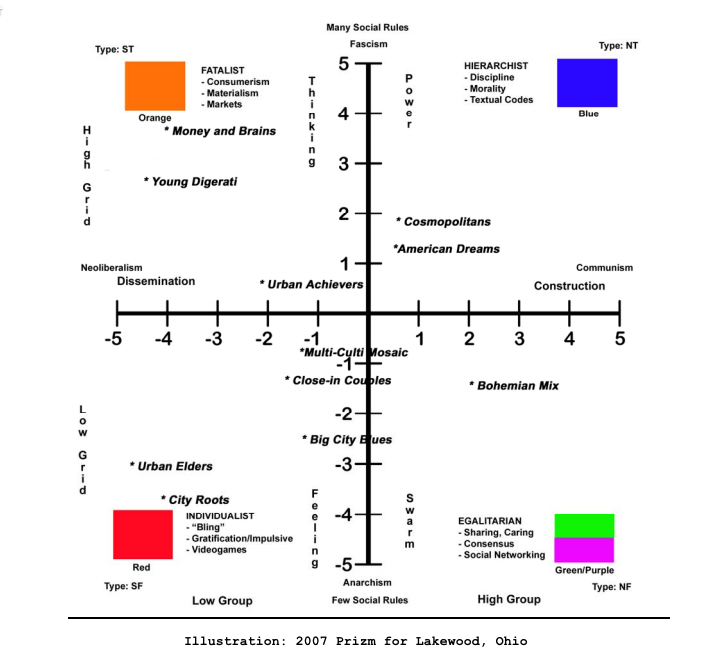
Lakewood Prism (demographic analysis schema)
(from a presentation by Kenneth Warren, – Lakewood Future Tools – Understanding Lakewood: Communities and Memes; March 2005) See also the pdf, Community Capacity.
(Lakewood Ohio) Place-Making with Good Neighbors on the Lake
· Flow =Quality of Life
· Increase the flow states in the community.
· Refresh the conventional sense of local living in Lakewood by engaging good neighbors.
· Cultivate the habit of good neighbors listening to one another.
· Activate through the Lake a sense of the liminal among good neighbors, that is, the threshold of physiological or psychological response to the unique energy that permeates the people and place.
· Make Lakewood permeable to new experience, ideas, mechanisms and structures among good neighbors
who are joining society to economy, conscience to knowledge.
· Obtain commitments from good neighbors to act on projects that will stretch beyond circular, selfjustified egocentric gated communities.
· Know there is a beginning point and ending point to each good neighborhood.
· Realize that a commitment to sustainability is shift in consciousness; it is not about constructing a pretty
fence.
· Understand that places and institutions can get high-jacked by interests that lie outside the particular community, i.e. absentee landlords, absentee corporations and absentee public employees.
· Construct IEDs – Improvised Economic Devises
Ken Warren, Lakewood Visionary Alignment
During the summer of 2006 I happened upon my current research focus, serendipity in adult development. Under the auspices of The Lakewood Observer and Lakewood Public Library, I devised a small project. I would quickly teach street anthropologists to conduct a survey, and then from their gathering of this data set, build out with them a very constrained ethnography focused on a single question, What brought you, [the subject,] to live in Lakewood?
For two weekends a dozen or so of us fanned out through Lakewood and conducted this survey. We then spent an afternoon debriefing the results. We never assembled the final work product, but, in reviewing the surveys on my own time, I realized an amazing quality threaded itself through many of the survey results.
I can capture this quality in one of the answers to the signal question.
My husband and I came to live in Lakewood because he had just taken a job at the hospital in Fairview Park and we were in a very temporary sublet in Rocky River. One day, at the grocery store there, I asked the gal at the cash register if she knew of any good resources for tracking down nice rentals in Rocky River. Before she could answer a woman standing behind me in the checkout line tapped me on the shoulder and told me that her sister had a first floor, two bedroom apartment available in her Lakewood house. I jotted her sister’s number down and we moved in the very next month.
Not only were the surveys littered with similar narratives, but having my nose pushed close to such stories compelled me to consider my own.
So: I had to reckon with the robber in 1974 who made it all possible by trying to kill me.
In other words, I discovered my interest in the problem of serendipity in adult development by reflecting on my apparently fortuitous encounter with a robber in 1974. This reflection itself was inspired by asking residents of Lakewood what was it that brought them to Lakewood to live.
Keynote: communities collect the results of serendipity.
(Technically speaking: communities aggregate the product of intricate conjunctions of agentic, environmental, and temporal fortuities.)
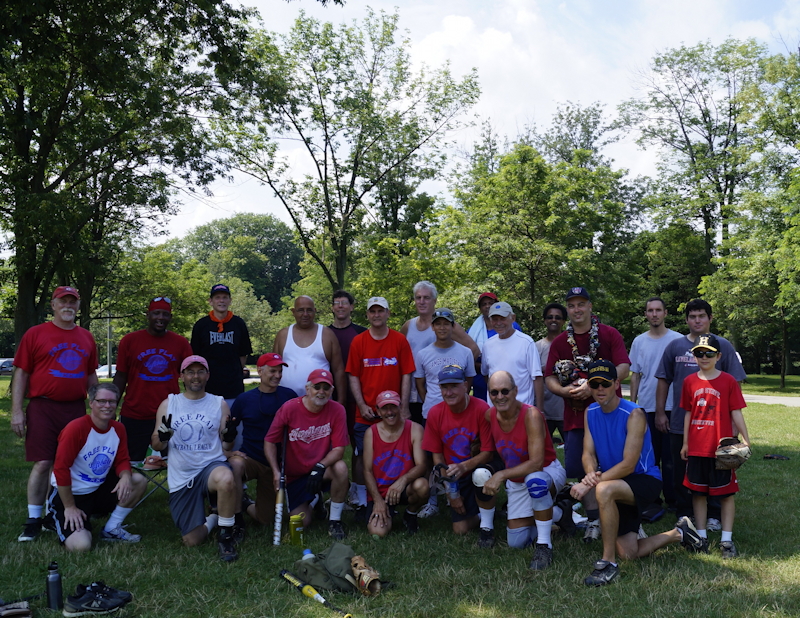
Twenty-three out of twenty-four attendees are in this photo from Sunday’s game. This was our best turnout so far.
Ideal conditions evoked a crisply played game. Just like last week, a single seven run inning staked one of the teams to a big lead. However, this advantage almost completely evaporated during a stirring top-of-the-seventh rally.
Free Play Softball, Sundays, 9:45am, at Forest hills diamond #8, Cleveland Heights.
Filed under adult learning, play
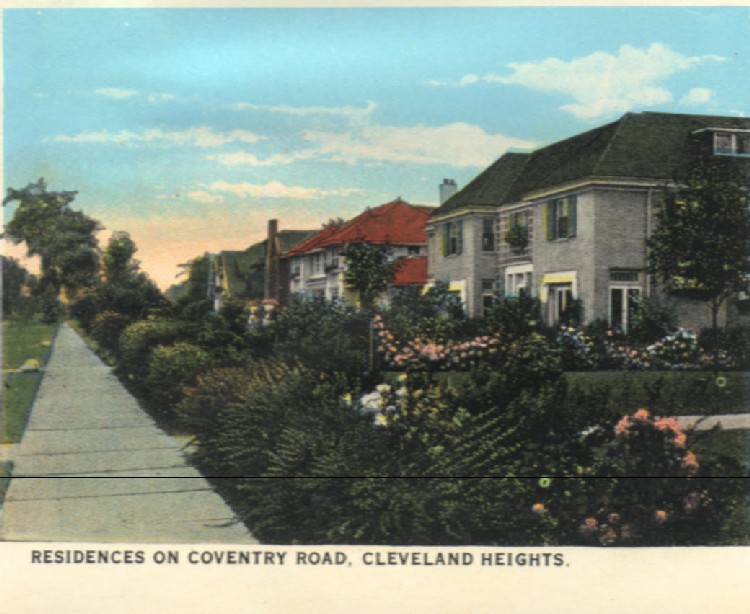
I. Home Coming (part one of three parts)
I dig Cleveland Heights; I’m from Cleveland Heights. My wife digs Cleveland Heights too, and we count ourselves blessed that after the challenging circumstances of my mother’s illness and passing, we moved from the apartment in her home in Shaker Heights we rented from her for almost five years to our new home in Cleveland Heights.
This new home is almost exactly one mile from my first family home on Ormond Road, and a tad more than a mile from the succeeding family home on East Overlook Road. It is the first home Susan and I have owned together and comes after twenty years of our being renters, most of the time in various neighborhoods of, yup, Cleveland Heights.
Personally, as an independent researcher recently concerned with the role of constructive fortuity, or serendipity, in adult development, it is worth noting three of many fortuitous events that staked me to my home town. The first was a family emergency that brought me back from Santa Fe, New Mexico in 1992, and the second was the teamwork of two realtors, and the intuition of one of them, to show us our current beloved house on the great Cleveland Heights street of Coleridge Road. Our house here is five blocks from where I went to elementary school between 1959-1961. The third lucky event is bookended by the aforementioned two: meeting my future wife and partner Susan as the result of a fix-me-up sponsored by a mutual friend. This first meeting unfolded at a September party on Grandview Road in 1993, in, sure, Cleveland Heights.
For Susan and I Cleveland Heights is congenial ‘to-the-max.’ Yet, a final fortuitous event was primarily instrumental in both my leaving Cleveland Heights, and, eighteen years later, returning. On a Thursday afternoon in June 1974, a guy walks into the record store I was assistant manager of, Music Madness. It was located next to the old CH Post Office on lee Road. He found me alone and more than willing, at gun point, to give him the contents of the cash register, and walk with him to the back room office, and give him the rest of the day’s cash. Then, after a frustrating for-us-both few minutes during which I tried to–by myself–tie up my hands, he beckoned me to lay down on the floor and once prostrated, he next shot me in the back at point blank range.
(Good ol’ Cleveland Heights; Lee Road could be a bit like the wild west in the mid seventies.)
I got the hell out of my home town, and took the bus to Vermont by the end of July.
Nevertheless, the way the very long chains of contingency, necessity, and fortuity operate to constitute the foundation of future events, the leave-taking is as necessary as the homecoming–is, in actuality, its required precedent.
Cleveland Heights news and Resources (these links will remain in the sidebar)
Cleveland Heights vCity Data
Cleveland Heights (City Hall)
Cleveland Heights Historical Society
Heights Observer
Future Heights
Sun Press
Cleveland Heights (Plain Dealer)
Cleveland Heights Patch
Coventry Village
Cedar-Lee
Filed under adult learning, Cleveland, Kenneth Warren, my research, serendipity
How Old Is the Human Race? va News.Discovery
The National geographic Genographic Project 2.0
A fifty percent increase in the age of our race is gigantic swing in a primary historical quantification.
The Genographic Project is a multiyear research initiative led by National Geographic Explorer-in-Residence Dr. Spencer Wells. Dr. Wells and a team of renowned international scientists are using cutting-edge genetic and computational technologies to analyze historical patterns in DNA from participants around the world to better understand our human genetic roots. The three components of the project are:
To gather and analyze research data in collaboration with indigenous and traditional peoples around the world
To invite the general public to join this real-time scientific project and to learn about their own deep ancestry by purchasing a Genographic Project Participation and DNA Ancestry Kit, Geno 2.0
To use a portion of the proceeds from Geno 2.0 kit sales to further research and the Genographic Legacy Fund, which in turn supports community-led indigenous conservation and revitalization projects
The Genographic Project is anonymous, nonmedical, and nonprofit, and all results are placed in the public domain following scientific peer publication.
Filed under science

He chooses Peace. He must be able to make a choice.Interview with Yukiyoshi Takamura in Aikido Journal
In an earlier post about the vigorous development of an anti-Constitution police and surveillance state, I referred to Carl Jung’s insight about the concretization of harmful utility from charged unconscious constellations of collective fears. A simpler way to describe this is to state that if we go looking for evil-doing we will project it on anything our unconscious is on the lookout for; then on, something like, everyone.
The Trayvon Martin tragedy connects with the surveillance state via the consequential vector of a collective unconscious complex. This complex encapsulates the dark side of our collective roots, roots anchored in how it was we created a nation from an American frontier that required the near extermination of the native inhabitants and the kidnapping and enslaving of Black Africans.
This primitive social complex compels our hyper-vigilance, and evokes the solitary vigilante. This vigilante may be found acting as the canary in neighborhood coal mines, or, he or she may be huddled over a computer screen waiting for algorhythmic processing to pop up a ‘suspicious’ character (or propensity,) out of an ocean of indiscriminate data.
This complex is archaic. It’s dark imperative is simple to name: tame the savages one way or the other. Or, as Frederick Turner put it in his book about it, Beyond Geography, its mission is “educating the children for citizenship.”
Among the concomitant terrible issues of this unconscious social complex are willful mistakes in ‘threat’ identification, and, slaughter.
Turner:
The murder of Sitting Bull was what led with terrific inexorability to the savage collusion of this business, for it confirmed the fears of the Sioux Ghost Dancers that the troops had been brought in to murder them all. Badly frightened but defiant Sioux huddled under Chief Bog Foot in the Badlands off the reservations where refugees from Standing Rock came bearing news of the murder. While they danced and awaited further news the troops surrounded them and began a kind of negotiation that ended with the dancers being prodded toward Pine Ridge Reservation December 27, [1880.] On the 28th the troops camped about 20 miles from the agency and plans were made to take from the dancers whatever arms they might have.
You another American dawn, but singular in its way, for what it broke upon was the end of something that vastly predated the corporeal realities of those who now faced each other across a tiny patch of clay-dry Indian soil. On the slopes of the little hillock stood 470 white men muffled and capped against the weather, their rifles greased, glinting, and government-issued, and there four big rapid fire cannons trained downhill. Among them, grim faced, expectant members of the US 7th cavalry–Custer’s outfit–sat their big horses and remembered the Sioux at Little Big Horn. And on the flats below some 340 ghost dancers camped in canvas lodges. The Indians were ordered to surrender their arms. They look at the surrounding guns and into their lodges full of women and children and then delivered up an obviously fallacious cache. So now the close-buttoned, anonymous-faced soldiers moved in, poking and kicking through the lodges while the women called to their men and the children cried. A shaman kept blowing an eagle-bone whistle. Some lodges were overturned and theirs content scattered. The sun rose.
A pitiful treasure of rifles, some of purely talismanic value, was this discovered, but when a soldier attempted to search the body of a young man, the latter drew a concealed gun and fired. In an instant the Indian threat, such as it had been, was exterminated as the gunners and riflemen dropped almost all of the men where they stood at the entrances to the lodges. But now the real battle began, inevitable and terrific. The whole civilization–Chicago and St. Louis and the older outposts eastward; fortresses, soldiers, and slave castles beyond the edges of the Old World; driven kings, commanders, prelators, and nameless spear carriers–all its gathered force poured down the greased barrels and into the screaming women and children who fled westward along winter’s dry gulch toward no refuge. The soldiers pursued them, mile after mile, while behind them a sullen smoke drifted up the smoldering canvases of the lodges.
Black Elk was there, having riden desperately out with others from Pine Ridge when the sounds of the heavy guns announced sure annihilation. Armed with his vision and nothing more he galloped his lathered pony through the smoking destruction out along the gulch,
“and what he saw was terrible. Dead and wounded women and children and little babies. . .scattered all along where they been trying to run away. The soldiers had followed along the gulch, as they ran, and murdered them there. Sometimes they were heaps because they had huddled together, and some were scattered all along. Sometimes bunches of them have been killed and torn to pieces where the wagon guns hit them. I saw a little baby trying to suck its mother, but she was bloody and dead.”
Numbers here are meaningless, but Gen. Nelson A.Miles in charge of operations, spoke truly when he laconically reported, “I think very few Indians have escaped.” (pp 293-294, Beyond Geography)
There is no space between the archaic wish to tame the savages ‘to the last man, woman, and child’ and the contemporary claim that enough vigilance, gun-wielding citizens and patriots, and surveillance will do the trick.
photographic inversion from While Seated.
Filed under current events, psychological anthropology
At the very beginning of this fascinating video capture of mssrs. Talen and Kahneman, the introducer asks for the two to provide seven word descriptions about what each is about.
It’s a good exercise. Play around with it.
(Taleb and Kahneman are important thinkers of course; Taleb especially figures into my research into constructive fortuity, although I would stand as an even more severe philosopher of ‘the chance ecology.’)

S.Calhoun – 2013 – Dervish Dancer No. 3
A boy, very attached to his pet pig, one day decided to enter it in a horse race. Much to his dismay the pig finished last and suffered the ridicule of all the horsemen. The boy was quite surprised, for, as he told one of the horsemen: “it makes no sense that a pig as fast as she was when she was a piglet shouldn’t grow up to be even faster!”
(I first heard this on a cassette of a lecture by Idries Shah.)
Filed under adult learning

via Mother Nature Network Too Beautiful to Be Real? 16 Surreal Landscapes Found On Earth
Longchenpa: You take what you need, images, offerings,
Books, cooking gear, whatever, and stay in solitude.
Right now you have it all together but later difficulties and disputes arise.
Don’t need anything – that’s my sincere advice.
‘So careful of the type?’ but no.
From scarped cliff and quarried stone
She cries, ‘A thousand types are gone:
I care for nothing, all shall go.‘Thou makest thine appeal to me:
I bring to life, I bring to death:
The spirit does but mean the breath:
I know no more.’ And he, shall he,Man, her last work, who seem’d so fair,
Such splendid purpose in his eyes,
Who roll’d the psalm to wintry skies,
Who built him fanes of fruitless prayer,Who trusted God was love indeed
And love Creation’s final law?
Tho’ Nature, red in tooth and claw
With ravine, shriek’d against his creed?Who loved, who suffer’d countless ills,
Who battled for the True, the Just,
Be blown about the desert dust,
Or seal’d within the iron hills?No more? A monster then, a dream,
A discord. Dragons of the prime,
That tare each other in their slime,
Were mellow music match’d with him.O life as futile, then, as frail!
O for thy voice to soothe and bless!
What hope of answer, or redress?
Behind the veil, behind the veil.Canto LVI In Memoriam
Alfred Tennyson
Initiatory experience is present in this very moment and nothing can be done to facilitate its advent. Any kind of preparation or fore-practice muddies the waters in its assumption of a goal to be reached. Access to the clarity and the zing of reality, on the contrary, is more likely to be found in an innocent pristine mind that has not been conditioned by the cultural and religious assumptions of a “sophisticated” tradition. Purity of karma, putative rebirth, degree of meditation-concentration, facility in visualiza- tion, levels of attainment, and so on, are all issues pertinent to acceptance and success within a hierarchical cult wherein a particular ideal form of social and psychological behavior is a goal to be achieved; but to the form- les s experience of Dzogchen such considerations have no relevance. Striv- ing in any kind of preparatory endeavor is an exercise in shooting oneself in the foot, or at least running after a mirage. In fact, to reach the point of relaxation in the moment that provides intimation of rigpa, nonaction is the sole precept. This perspective in radical Dzogchen is exclusive to those who have no need or inclination to exchange their inbred cultural norms and mores for those belonging to a more exotic or “spiritual” tradition, or to reject their cultural legacy and educational conditioning in an effort to change their psychological make-up. Recognition of our lived experience, jus t as it is, in its miraculous immediacy and beauty, without any yen for change, is the praxis of radical Dzogchen, and belief in personal develop- ment and improvement, progress toward a social ideal, moral evolution of the species, and so on, is deviation from the pure pleasure of the unthought timeless moment. (Keith Dowman) from Natural Perfection. Longchenpa’s Radical Dzogchen – Translation and Commentary by Keith Dowman
Filed under adult learning

S.Calhoun – 2013 – Untitled Excerpt #2
When I post this to the gallery I will detail the process and workflow. The above ‘workshop’ piece–workshop designating not yet finalized–began as an excerpt, a 5% clip, from a larger source; below.
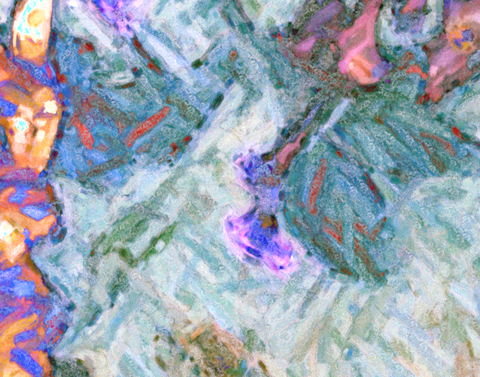 <
<
Filed under visual experiments, my art
I’m taking the photo, so we added up to 22 free play players Sunday. Six new players have joined us. Yes! For the second week in a row Mark Jr. and I picked teams in schoolyard fashion. Unlike last week’s one run game, this tilted intensely in the last two innings. Mark and I debriefed our disparate picking strategies after the game and he saw the risk involved in putting four brawny first basemen on his team.
In row two, fourth player in is Vincent. He is eleven. Without any comment he is being allowed to play even if he’s a few year’s shy of the lower age limit. He’s around forty years shy of the average age of our participants! He made the play of the game at second base, backhanding a looping drive while moving to his left. It occurred to me he may well be our most serious player. He’s the only one of us who has a chance to make the big leagues.
Our average age, Vincent, and my appreciation of Richard Thompson compel me to end on a musical note. (Free Play Softball league: Sundays, 9:45am, Field #8, Forest Hills Park, Cleveland Heights, Ohio.)
Filed under adult learning

A Yellow Rose – 2013
S. Calhoun; from a photograph
Do you know a word that doesn’t refer to something? Have you ever picked and held a rose from R O S E ? You say the NAME. Now try to find the reality it names. Look at the moon in the sky, not the one in the lake. If you want to be free of your obsession with words and beautiful lettering, make one stroke down. There’s no self, no characteristics, but a bright center where you have the knowledge the Prophets have, without books or interpreter.
When you are with everyone but me, you’re with no one. When you are with no one but me, you’re with everyone. Instead of being so bound up with everyone, be everyone! When you become that many, you’re nothing. Empty.
Rumi, ra
Filed under sufism

Scott Adams’s Dilbert here replicates one of the classic learning forms given in Sufi teaching stories. There even is a common saying that covers this form: ‘Be careful what you wish for.’ The hidden aspect at the first level–in formal terms–concerns ‘features’ that come along for the ride, so-to-speak. In this instance, you get the head’s up about the downside of working hard, and the grim prospect comes along for the ride.
Dig deeper and this is also about one-sidedness and obsession. But, you didn’t ask about these!
Filed under adult learning, humor
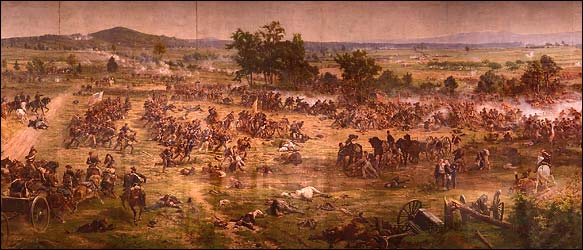
I’ve been reading Colonel Robert Bateman’s series on the Battle of Gettysburg at Charles Pierce’s Politics blog at Esquire. The good Colonel has used exemplarary moments to capture the battle’s human consequences in his necessarily episodic and compressed essays. Bateman emphasizes the Union’s remarkable successes in crucial smaller scale confrontations with larger Confederate forces. These eventually lead into the large scale catastrophe of Pickett’s Charge.
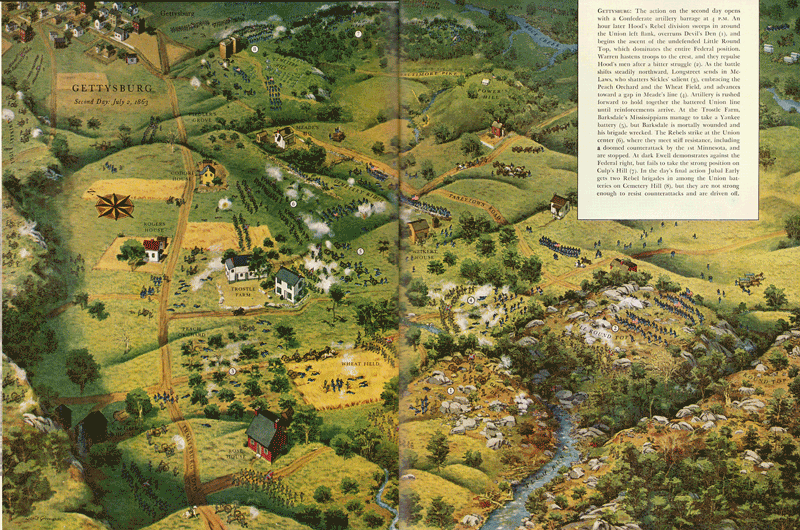
This map was patched together from a scan of the two page map in The American Heritage History of the Civil War, a favorite book from my youth.
On thie 150th anniversary of the battle, the web resources are many and I highly recommend searching the terms /interactive /Gettysburg / /map.
Gettysburg
by Herman Melville
O Pride of the days in prime of the months
Now trebled in great renown,
When before the ark of our holy cause
Fell Dagon down-
Dagon foredoomed, who, armed and targed,
Never his impious heart enlarged
Beyond that hour; God walled his power,
And there the last invader charged.He charged, and in that charge condensed
His all of hate and all of fire;
He sought to blast us in his scorn,
And wither us in his ire.
Before him went the shriek of shells-
Aerial screamings, taunts and yells;
Then the three waves in flashed advance
Surged, but were met, and back they set:
Pride was repelled by sterner pride,
And Right is a strong-hold yet.Before our lines it seemed a beach
Which wild September gales have strown
With havoc on wreck, and dashed therewith
Pale crews unknown-
Men, arms, and steeds. The evening sun
Died on the face of each lifeless one,
And died along the winding marge of fight
And searching-parties lone.Sloped on the hill the mounds were green,
Our centre held that place of graves,
And some still hold it in their swoon,
And over these a glory waves.
The warrior-monument, crashed in fight,
Shall soar transfigured in loftier light,
A meaning ampler bear;
Soldier and priest with hymn and prayer
Have laid the stone, and every bone
Shall rest in honor there.
Filed under history